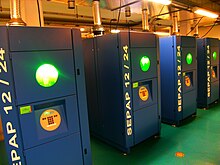This article has multiple issues. Please help
improve it or discuss these issues on the
talk page. (
Learn how and when to remove these template messages)
|
The National Centre for Evaluation of Photoprotection (NCEP), also known as the National Institute for Evaluation of Photoprotection, is a French research center dedicated to the study and analysis of plastic materials, including identification of failed mechanisms and study of material durability. [1]
Overview
The center's research specializes in improving the safety and effectiveness of plastics. Key methods include conducting physicochemical analyses to determine the causes of material failures. A significant part of this process involves the use of both artificial and natural aging tests to predict the long-term performance and stability of these materials. This research plays an essential role in enhancing the reliability and safety of polymer-based products, including nanocomposite and composite materials with polymer matrices.
History

The National Institute for the Evaluation of Photoprotection is a subsidiary of Blaise Pascal University and was created in 1986 by Professor Jacques Lemaire, former head of the Laboratory of Molecular and Macromolecular Photochemistry (LPMM) [2]. Initially, the center's goal was to transfer LPMM's research on polymer photoaging to industrial companies facing increasing problems of plastic degradation, such as yellowing and bleaching. [2]
The center remains associated both with the LPMM and companies in the field of polymer applications. [3] CNEP utilizes tools for the physicochemical analysis of polymer material degradation such as, infrared and UV-Visible spectroscopy. The center serves as an interface between polymer producers, transformers, and constructors. Additionally, CNEP is carrying out the Papylum Project to develop expertise in the analysis and primarily restoration of organic material involved in works of art [4] [5] as well as the determination of common initial properties of polymers. [6]
See also
- Plastics
- Nanocomposite
- Composite materials
- Polymer
- Oxidation
- Polymer degradation
- Quality control
- Standardization
- Photochemistry
- Weather testing of polymers
- fr:Photovieillissement accéléré en SEPAP (French)
- Weathering
Notes and references
- ^ "CNEP (Centre National d'Evaluation de Photoprotection) - Aero Cluster" (in French). Retrieved 2024-02-05.
- ^ "Our experience". Retrieved 2024-04-13.
- ^ "they trust us". Retrieved 2024-04-13.
- ^ painting, sculptures, archeological sites, monuments, contemporary art, modern and ancient papers, etc
-
^
"Papylum Project is a way for us to detail our knowledge on the mechanism of degradation of paper". www.science4heritage.org. Retrieved 2024-06-22.
CNEP SPENDS 15% of its activity studying materials used in conservation and restoration of works of art, particularly on paper. CNEP developed a new approach based on chemical evolution of organic materials to explain the degradation of their mechanical properties. The Papylum Project is a continuation of a research project conducted in collaboration with Bibliothèque Nationale de France. Papylum Project is a way for us to detail our knowledge on the mechanism of degradation of paper.
- ^ gas and water permeability, crystallization, density, molecular weight, melt flow index, etc (see equipment list on [1])